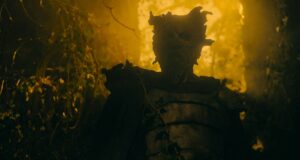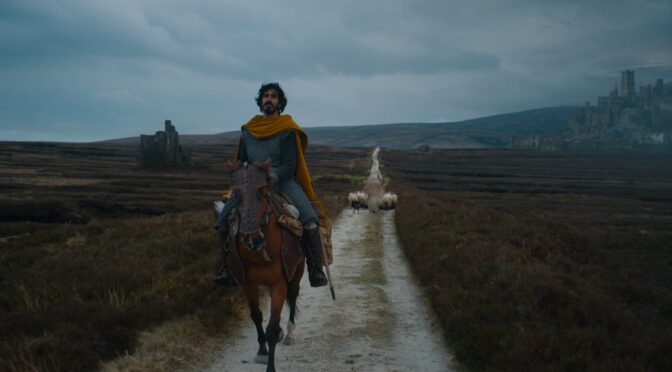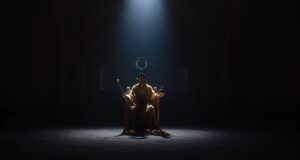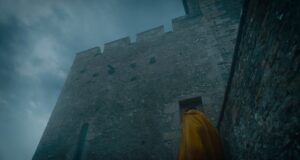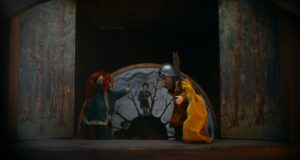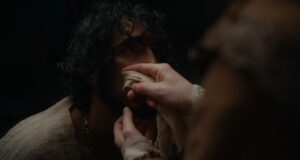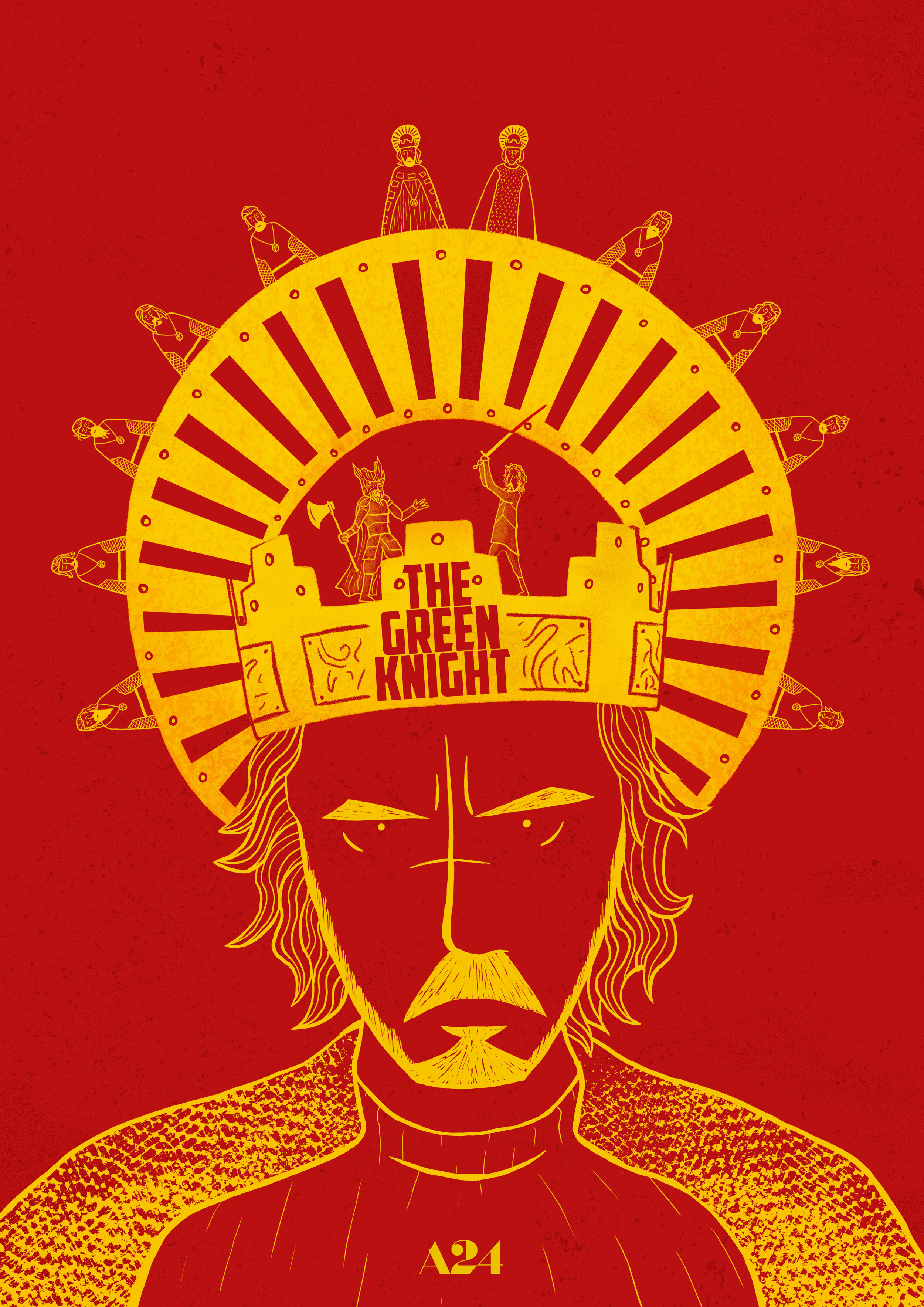
It seems a little funny that the 2022 Academy Awards went in so rapturously for King Richard, a modern sports film with a title that makes it sound like it could be about a medieval sovereign, yet turned a blind eye to the numerous stories of Old World regal gallantry that 2021 had to offer. It was something of a small boom year for stories from the pre-Middle Ages, between Joel Coen’s stunning and singular expressionist take on Macbeth to Ridley Scott’s trenchant and triumphant late career peak, The Last Duel. Scott’s film felt bracingly modern, while Coen’s The Tragedy of Macbeth felt brackishly ancient, like a primeval curse dredged out of the depths of a steaming swamp. David Lowery’s The Green Knight, 2021’s high watermark for cinema that could have been adapted from an illuminated manuscript, falls into that ancient, yellowed Macbeth camp. Its greatest aesthetic virtues (it is the kaleidoscopic counterpoint to Tragedy of Macbeth‘s chilly blacks and whites) make us feel a million miles removed from the present day and maybe from any day that ever existed. We feel the chill of the truly strange and inscrutably archaic, the sense that ghosts and lost spirits are lurking not far from us. As with Macbeth, a high and reaspy voice ushers us into the story. It speaks softly at first of King Arthur and we gaze upon a floating crown descending onto the head of some shadowy robed figure in a dimly lit throne room. Then it intones, “But this is not that King,” and the anonymous monarch bursts into a roaring crackle of flames. The voice rises to a Gollum-like bellow as it promises a rousing tale. There is a kind of dissonance at work. The words themselves are not sinister; the speaker is simply promising a rousing story to come. But her voice is beyond disquieting. DIrector David Lowery wants us to feel off balance and just the right amount of menaced. Adventures and wonders lie ahead, but he is also letting us know that his The Green Knight will be tinted with an air of the ominous and unknowable. If we are expecting a swashbuckler, he is preparing us for something with a lot more dread, mystery and danger than we are used to from the average knight’s tale. It’s not uncharacteristic of this relatively young auteur. The man who made A Ghost Story can’t resist imbuing his latest and best film with a touch of the spectral.
While past Lowery films like A Ghost Story and the elegiac Robert Redford bank robber tone poem The Old Man and the Gun had some bravura setpieces to recommend them, their aesthetic was also decidedly lo-fi at the same time. To use a music metaphor, The Green Knight is Lowery’s chance to leave the bedroom studio and make what feels like a glam record by comparison. From its atmospheric, dizzyingly edited Christmas Day opening to its giddy, head-dropper of an ending, The Green Knight is Lowery’s first complete showstopper. It’s a gorgeously tactile, bewitching, and frequently disquieting bit of old legend come to life. In telling the tale of Gawain (not yet Sir Gawain of Arthurian fame when we meet him) and the Green Knight, it feels like Lowery himself is entering the royal banquet hall of King Arthur and answering the ruler’s call for an outrageous and stupefying story of bravery and peril; of men not only leaving home but leaving the comfort zone of a physical realm they thought they knew. The Green Knight‘s story begins on a Christmas morning when heedless, cocksure Gawain (a striking and terrifically dialed-in Dev Patel) leaves his mother and lover to go dine in the castle of his uncle, King Arthur. The kindly, aging King graciously offers Gawain an empty chair next to him and his Queen. Then the good King rises from his seat and asks for one among his dear guests to bewitch him with a great story of derring-do. Before any man can step up to answer the call, however, the titular Green Knight himself (or itself) strides into the hall to kick David Lowery’s movie into action. He is plainly something other than a mere man. He has a face like a tree trunk and a beard of mossy green bark. With each step he emits low creaks like a swaying ship’s mast. This unsettling being removes a large axe from its sheath and proposes a yuletide game to all present. He will offer any man the chance to strike him in whatever place he chooses and as hard as he likes. In turn, that man must journey far away to the Green Chapel exactly one year from this day, seek out the Knight and let him return that same blow. Ambitious, invincible Gawain steps up and borrows a sword. The King emphatically reminds Gawain that this is only meant to be a game. Gawain barely registers his wise uncle’s warning. He surges angrily forward as if into battle and cleaves off his arboreal challenger’s head. But the Green Knight does not die. He merely picks up his own detached head, mounts his steed and rides from the castle leaving two chilling words ringing in the impetuous youth’s ears: one year. What follows is Gawain’s quest to seek out his destiny and to reckon with the reality of his own likely beheading.
What Lowery, adapting a classic, albeit lesser-known, piece of Arthurian legend, is doing is to challenge Gawain in much the same way as the Green Knight does in that early showdown. The idea is to test the hotheaded, action-oriented notion of what an adventure story must be. Gawain fails to recognize the Knight’s challenge as friendly gamesmanship and his empty, short-sighted braggadocio sets him on an entirely different kind of hero’s journey. One that he may very well never return from. Lowery’s tale is full of gob-smacking wonder, ingenious effects and eye-popping cinematography, but it is unlike a great many tales of brave knights. For all his posturing, Gawain is not a knight and he rarely, if ever, acts bravely. Lowery has no intention of making Gawain look like a swashbuckling badass because he is nothing of the sort. If Gawain is to maybe one day become the figure of Arthurian legend that he is meant to be, he must slay the dragon of his own blustery youth first. From encounters with bandits to doing a favor for a martyred girl’s ghost, the chapters of Gawain’s story consistently undercut and deflate him. If nothing else, The Green Knight is a great tale of what it means to be young, dumb and full of one’s self. By contrast, Sean Harris keenly and movingly plays the great King Arthur, that most celebrated of legendary kings, not as a chest-thumping showboat but as a man whose encroaching years have blessed him with kindness and soft-spoken humility. It is for the young to see heroism as a thing of braying outward confidence. But what Gawain’s regal uncle values most is his nephew’s integrity; that he learns from his macho mistake and somehow finds the good fortune to return to him alive. He knows that if Gawain can somehow survive the cost of his own juvenile egotism, he might get far enough away from these youthful delusions of invincibility and one day become a person worthy of a real hero’s tale. But he must account for his actions alone. He must be willing to die if he’s to have any chance of becoming a great man; the great man he foolishly thought he could become with one rash swing of a borrowed sword.
What makes The Green Knight radical and refreshing isn’t just how vibrantly it distills the pure psychedelic essence of Arthurian lore. It’s in how Lowery investigates and tweaks the notion of what a hero’s tale can (and maybe more often should) be. The most uninvolving hero’s journeys concern protagonists who are already set in stone; perfect and competent with no need of improvement or growth. The folly of too many such stories is conceiving of the journey as a mere traversal across terrestrial distance when it is much more important to map the aspiring hero’s journey across the landscape of their heart and conscience. We should track them as they trek across the undiscovered lands of their own integrity and will. It is the a thread common to heroic narratives as varied as Die Hard’s John McClane in Nakatomi Tower and Frodo Baggins on the road to Mordor that a hero should undergo a trek across their inner selves to mirror and refract their physical journey. Gawain’s mission is fascinating not only because it is rich in incident and otherworldly sights, but because of how much it challenges his emotional maturity at every step. Which is to say what little emotional maturity he has has at this early and impulsive stage of his life. And the real test is not surviving the volley of bandits, ghosts and giants he encounters, but the impossible passive gauntlet that waits in the Green Chapel. All the strange new dangers rattle him far less than the certain test at the end of the road. In Lowery’s tale, all the unknown in the world is a cakewalk when compared to the thing Gawain knows he must do. For all its rousing setpieces, the journey of The Green Knight and Gawain steadily wends away from macho antics and feats of physical prowess. Temper and rash action have caused all of Gawain’s woes and now the real test of manhood is whether he has the integrity to honorably, humbly submit to his challenger and give up what he owes. Some thrilling spectacle occurs along the way, but the real voyage of the film is Gawain’s quest to find true valor and honor. An honor that is meek and humble and entirely in opposition to ostentatious, stereotypically manly chest-thumping.
The Green Knight is a story of human frailty and pride. Gawain starts the film arrogant and blind. He is a callow Prince Hal laboring under the delusion that he is already Henry V. He has done precious little in his life but drink and fuck at the time that he steps up to what he mistakes as a basic feat of masculine might. David Lowery’s target is the kind of ego and insecure bluster that masquerades as strength. To quote the animated series Steven Universe (another great hero story that is more interested in its hero’s inner journey toward emotional maturity than in the battles he fights), Gawain must learn to be strong in the real way. And the very real possibility that he may not live to apply the genuine strength he acquires just makes his challenge all the more poignant. While they may not appear to have a lot of superficial similarities (apart from the fact that both contain a ghost), what connects The Green Knight to Lowery’s masterful A Ghost Story are characters stubbornly clinging to old notions of reality and the need for them to complete painful metamorphoses, even if it radically alters or ends life (or death) as they know it. What fate awaits Gawain past his daunting challenge remains unclear to us and to him right up to the film’s final frame. But that is very much the idea. The true valor he has been unwittingly marching toward is the courage to move toward what he does not know; to accept what lies beyond the veil between a world he vainly thought he and whatever comes next. The fact that the next chapter for Gawain could be either adulthood of his bloody demise just means that true maturity entails coming to terms with our own endings. Whether it is the end of youth, of ego, or of our very lives is irrelevant. Whatever it is that lies at the conclusion of our journeys, we must reckon with it if we are to ever see ourselves as people worth looking up to. And after all the bravado and action, it is the quiet acceptance of things we can neither control nor change that truly tests our mettle.
The Green Knight is also a Christmas movie (that is, one set during the yuletide season) that actually feels possessed by a kind of Christmas spirit. Like A Christmas Carol, it is a bracing, wintry parable about a human being who must learn a lesson and change for the better. There is some mystery as to whether it is too late for him, but there is a hope that it might not be. The tale is filled with an atmosphere of December. A brisk chill in the air, the smell of food wafting through hallways and alleys, and an ineffable feeling of mystery and magic hanging over everything. And kicking it all off is a group of merry revelers huddled together, drinks in hand, ready to be transported by a story. But instead of these knights hearing an old tale of courage and peril, it is we the audience that are brought in through the screen and given the chance to see an old legend play out in a new and exciting way. A chance to delight in things ethereal and supernatural, ephemeral and inexplicable. An occasion for wide-eyed wonder. But also, like any good Christmas tale, it is an occasion for inward reflection and the fortifying of conscience; to find ourselves in the story. In presenting the tale of a thoughtless mistake, it is implicitly also a story of wanting to do better even if we do not yet understand how. It is a reminder of the goodness and the weakness inside of us and the hope of a fresh chance to commit to the path that is virtuous and true and more often than not arduous. The Green Knight sparks the imagination and warms the belly like a pewter mug full of mulled wine. It is a film I look forward to adding to my own list of Christmas cinema classics. A beautiful and sparkling bauble and a bewitching morality play. A festive thing of beauty to be unpacked and treasured at the end of each too short year.